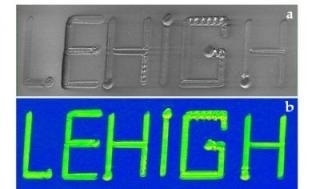Mar 23 2016
A team of physicists and materials scientists at Lehigh University have developed a new technique to create single crystals, where a broader range of materials can be employed in high-technology applications such as solar energy devices, microelectronics, etc.
 A scanning electron micrograph (a) and an image quality map (b) of that micrograph demonstrate the ability to fabricate patterned single-crystal architecture on a glass surface. In the lower image (b), the green color represents a single crystal embedded in the blue glass background. The width of lines in the two figures is about five micrometers. (CREDIT Dmytro Savytskii, Brian Knorr, Volkmar Dierolf & Himanshu Jain)
A scanning electron micrograph (a) and an image quality map (b) of that micrograph demonstrate the ability to fabricate patterned single-crystal architecture on a glass surface. In the lower image (b), the green color represents a single crystal embedded in the blue glass background. The width of lines in the two figures is about five micrometers. (CREDIT Dmytro Savytskii, Brian Knorr, Volkmar Dierolf & Himanshu Jain)
According to the researchers, the latest advancement has potential for solid materials, including glasses, with random atomic structures to be developed in a single-crystal form as is silicon. Silicon is currently the leading semiconductor material in the world. The study has been published in a Nature journal, Scientific Reports, under an article titled "Demonstration of single crystal growth via solid-solid transformation of a glass."
The solids, in a single-crystal form, would exhibit the remarkable properties needed in high-technology applications. The researchers explained that such applications comprise of light-emitting diodes (LEDS) and lasers, where a substrate is deposited with epitaxial-growth layering of thin single-crystal films to develop semiconductor devices.
Himanshu Jain, one of the four authors of the paper, informed that the melting process is used to grow single crystals of silicon. However this process changes or decomposes other useful materials, rendering them ineffective.
The boundaries between the tiny crystals in polycrystalline materials are weak or bad links and give the materials undesirable properties. A single crystal, having no boundaries, has superior properties. It is stronger mechanically in corrosive environments, it is electronically superior and it transmits light well.
Himanshu Jain, Professor of Materials Science and Engineering, Lehigh University
Using a new heating method, the researchers were able to transform glass into a single-crystal form without having the glass to go through a liquid or gaseous phase, and without producing any unnecessary nuclei or crystals.
"In this first unambiguous demonstration of an all-solid-state glass [to] crystal transformation, extraneous nucleation is avoided...via spatially localized laser heating and inclusion of a suitable glass former in the composition," the research team wrote in Scientific Reports.
Dmytro Savytskii is the lead author of the Scientific Reports article and also a research scientist at Lehigh’s department of materials science and engineering. The other authors include Volkmar Dierolf, distinguished professor and chair of Lehigh's physics department, and Brian Knorr, an assistant professor of physics at Fairleigh Dickinson University. Knorr got his Ph.D. in physics from Lehigh in 2014.
Jain informed that in a single crystal, a material’s atoms are assembled in a well-organized 3D lattice structure. In order to create a huge single crystal of silicon, a small seed of single-crystal silicon is taken and pulled up from the melted silicon; the atoms of this melted silicon are deposited on the seed in a 3D lattice structure. Based on the rate at which the crystal is pulled up, a large or small single crystal of silicon materializes as the melt cools down.
A contrasting technique was developed by Jain's group to create a single crystal of an antimony-sulfide chalcogenide glass. In order to promote the development of a crystal within the glass, the team employed a laser to heat up the glass from room temperature to a crystallization temperature, which was far less than its melting point. Using the combination of microscopy color mapping and electron-diffraction, the group were able to identify the direction of atomic configurations, and demonstrated the formation of single crystallinity at various places of the sample.
Jain observed that the development of the single crystal takes place as the glass is heating up, and does not occur when its melt is cooling down, as is the case with silicon. This can be easily viewed in scratches, which run across the length of the glass via the single crystal produced by the laser. After melting the glass, the scratches would smooth out and be eliminated.
Once we make the single-crystal line, we backtrack to get additional parallel single-crystal lines and eventually a single-crystal-layer surface on top of the glass. We can stitch these lines to convert the entire glass surface into a single crystal.
Himanshu Jain, Professor of Materials Science and Engineering, Lehigh University
Jain added that the team’s aim is to apply a sufficient amount of heat so that the disordered atoms in the glass can assemble into a single crystal without prompting the nucleation of unnecessary crystals.
We want just one nucleus to form. If we get multiple nuclei, we end up with a polycrystalline ceramic material with undesired properties.
Himanshu Jain, Professor of Materials Science and Engineering, Lehigh University
In order to eliminate extraneous nucleation, a focused laser was used to restrict the amount of the heated glass, enabling the formation of a single nucleus. This nucleus is rapidly grown into a crystal.
"We show that unwanted additional nucleation can be avoided by decreasing the volume of the heated region and growing the crystal by moving the laser beam at a sufficiently fast rate such that there is no time for forming extraneous crystals," the research group reported in Scientific Reports.
Another method was developed by the team that relies on a glass of a predesigned composition of iodine, sulfur, and antimony. As the crystal starts to form and grow, the iodine gradually shifts out of the crystal and enters the adjacent glass, where it tries to restrain nucleation.